Choosing Winter-Flowering Viburnum With Gary Ladman From Classic Viburnums Plant Nursery
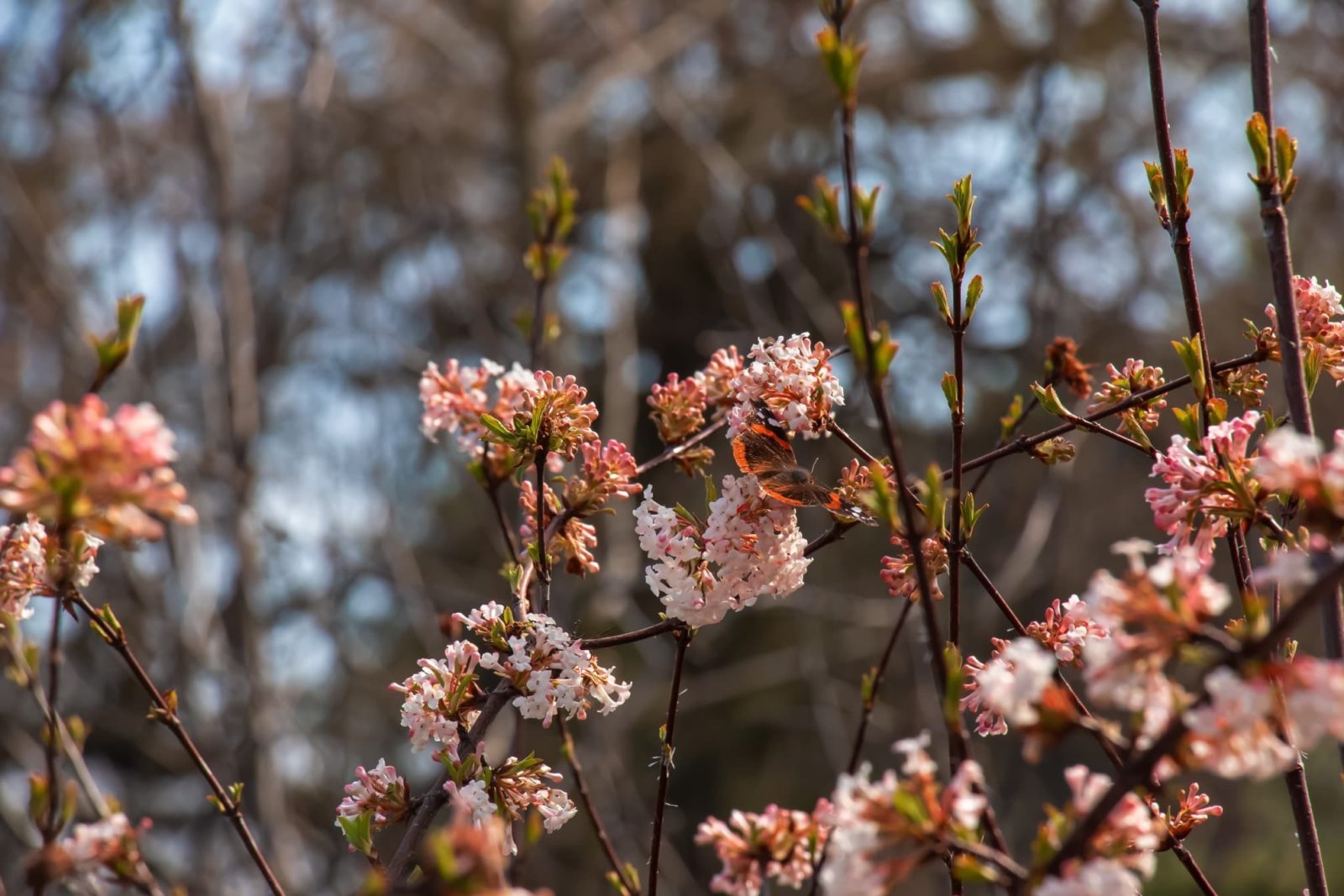
SHRUBS > VIBURNUM > VARIETIES > WINTER-FLOWERING
Reviewed By COLIN SKELLY

Colin is a Horticulturist and Horticultural Consultant with experience in a range of practical and managerial roles across heritage, commercial and public horticulture. He holds the Royal Horticultural Society’s Master of Horticulture award and has a particular interest in horticultural ecology and naturalistic planting for habitat and climate resilience.
Contributions From GARY LADMAN

With 52 years of experience working in horticulture, Gary Ladman is the Co-Owner of specialist plant nursery Classic Viburnums, which is based in Nebraska in the US. Gary has a degree in Horticulture and breeds many Viburnum cultivars with his wife Sue.
IN THIS GUIDE
Not only are they low-maintenance and fairly easy to care for, but viburnums also produce aromatic floriferous blooms that can add a splash of colour to any garden display.
In addition to that, there are viburnums that bloom in each of the four seasons – even in winter.
We spoke to Gary Ladman, the Co-Owner of plant nursery Classic Viburnums, about his favourite viburnums to grow.
“With 150 plus known species and more still being discovered, the genus viburnum offers immense diversity, making it next to impossible to not find a viburnum to fit a particular site or need,” says Gary.
“Asking me to name my favourite viburnum is like asking me who my favourite child is!
“Viburnums have at least 3 seasons of interest while some also have winter interest, so my favourites are constantly changing as the seasons change.
“In other words, they are all my favourites, it just depends on when you ask me.”
Underneath I present 12 viburnum varieties that are guaranteed to bring you colourful flowers and foliage, fragrance or berries throughout the dead of winter.
Keep in mind that all of the plants listed below can be grown in most soil types with any pH.
1) V. tinus ‘Eve Price’
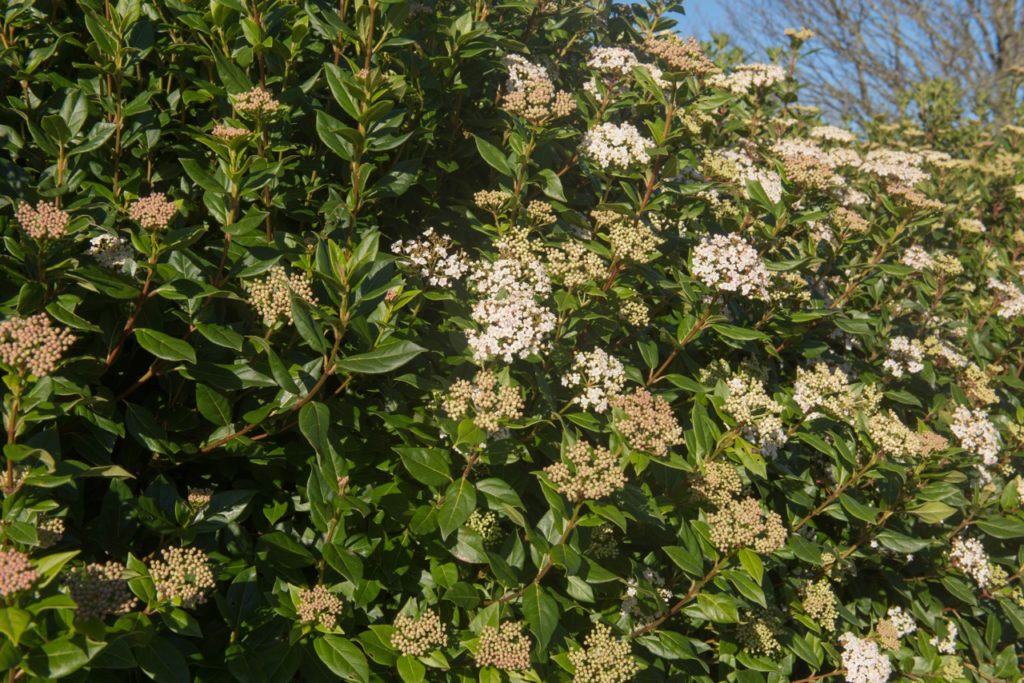
- COMMON NAME(S): laurustinus ‘Eve Price’
- HARDINESS RATING: H4
- FLOWERS: pink and white
- FRUIT: blue
- FRUITING SEASON(S): autumn
- SUNLIGHT: full shade / full sun / part shade
Viburnum tinus is the undisputed champion of winter-flowering types, and we open with one of its AGM-winning cultivars – ‘Eve Price’.1Ornamental Plants. (2021, July). Royal Horticultural Society. Retrieved March 27, 2023, from https://www.rhs.org.uk/plants/pdfs/agm-lists/agm-ornamentals.pdf
Its delightful leaves are perfectly ovate and of a rich green shade.
This cultivar produces red buds that open to pink-tinged white flowers in clusters.
As buds form and open continuously over a period of time, the happy outcome is clusters of mixed red and white from mid-winter to late spring.
2) V. tinus ‘Gwenllian’
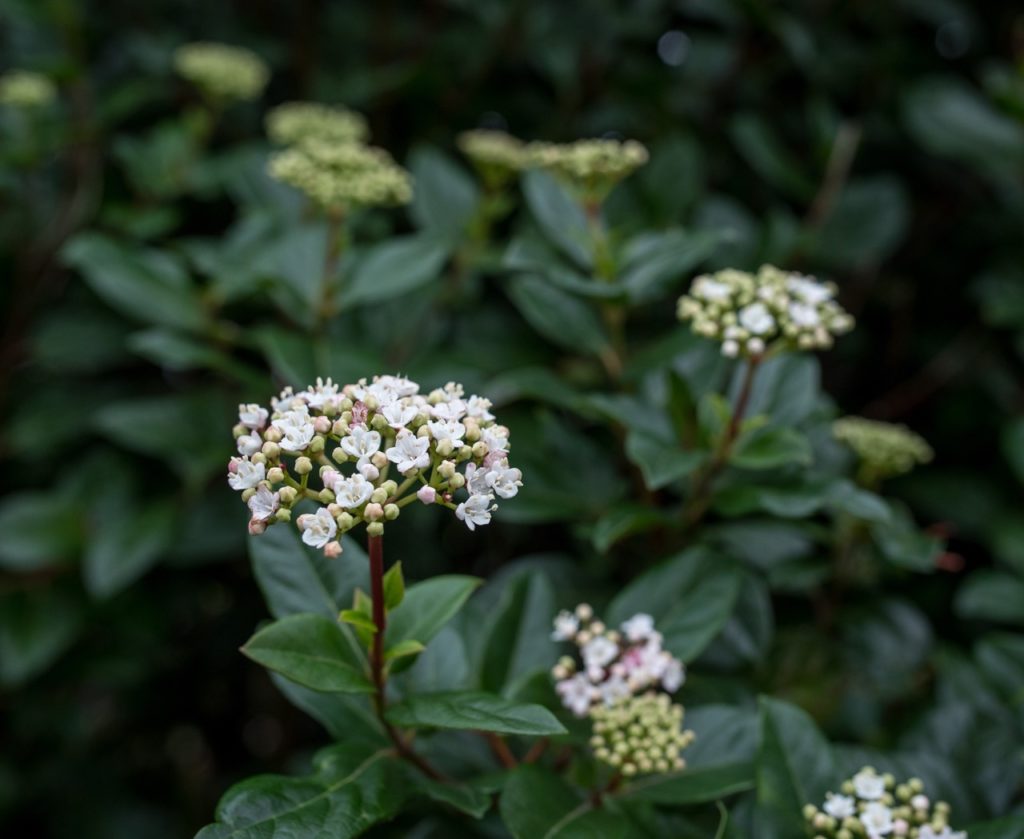
- COMMON NAME(S): laurustinus ‘Gwenllian’
- HARDINESS RATING: H4
- FLOWERS: pink and white
- FRUIT: blue
- FRUITING SEASON(S): autumn
- SUNLIGHT: full shade / full sun / part shade
Bushy and of a naturally tidy habit, ‘Gwenllian’ is another brilliant evergreen shrub, not too dissimilar from ‘Eva Price’.
Over much of the season, this cultivar forms bright red buds that open to little star-shaped yellowy-pink flowers which fade to white.
This means that you can often see mixed red, pink and white clusters from mid-winter into spring.
Autumn brings yet another colour in the form of dark blue berries.
This plant is also a recipient of the RHS Award of Garden Merit.
3) V. tinus ‘Lisarose’
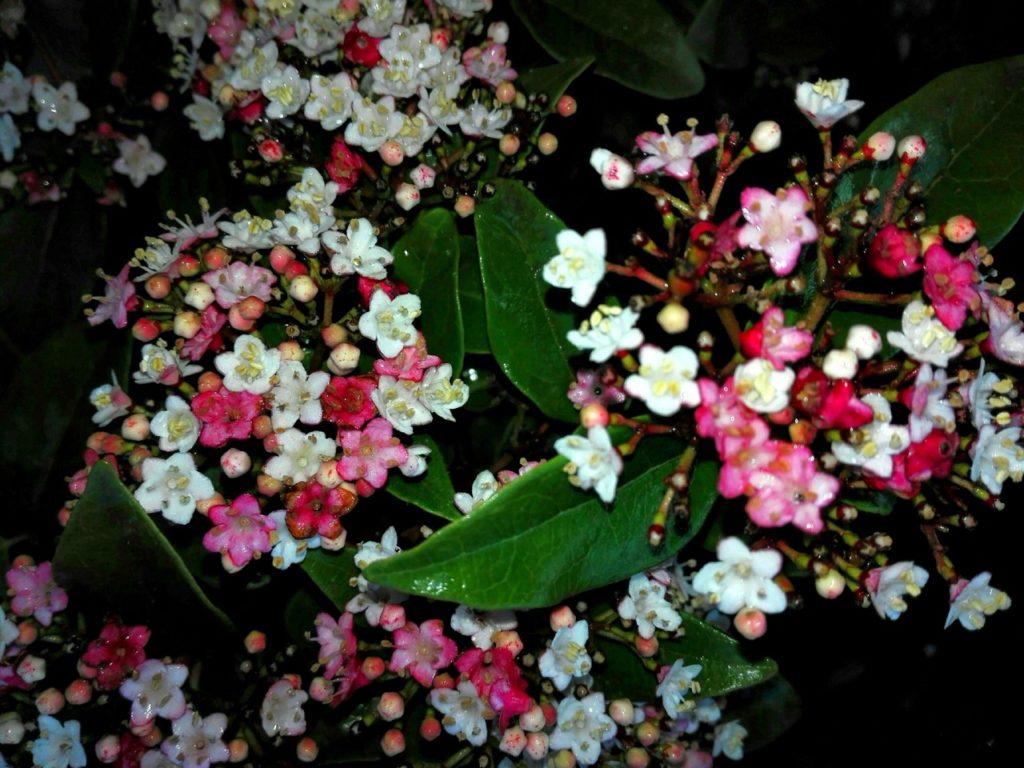
- COMMON NAME(S): laurustinus ‘Lisarose’
- HARDINESS RATING: H4
- FLOWERS: pink and white
- FRUIT: blue
- FRUITING SEASON(S): autumn
- SUNLIGHT: full shade / full sun / part shade
‘Lisarose’ flaunts rose pink flowering stems in autumn on which pretty buds of the same hue are on show.
These start opening in winter, producing round clusters of small pinky-white flowers interspersed with those rose pink buds.
The flowers continue into mid-spring with deep blue berries setting in late summer.
Reaching around 2m in height and spread, it displays evergreen foliage of a deep green shade.
4) V. tinus ‘Israel’
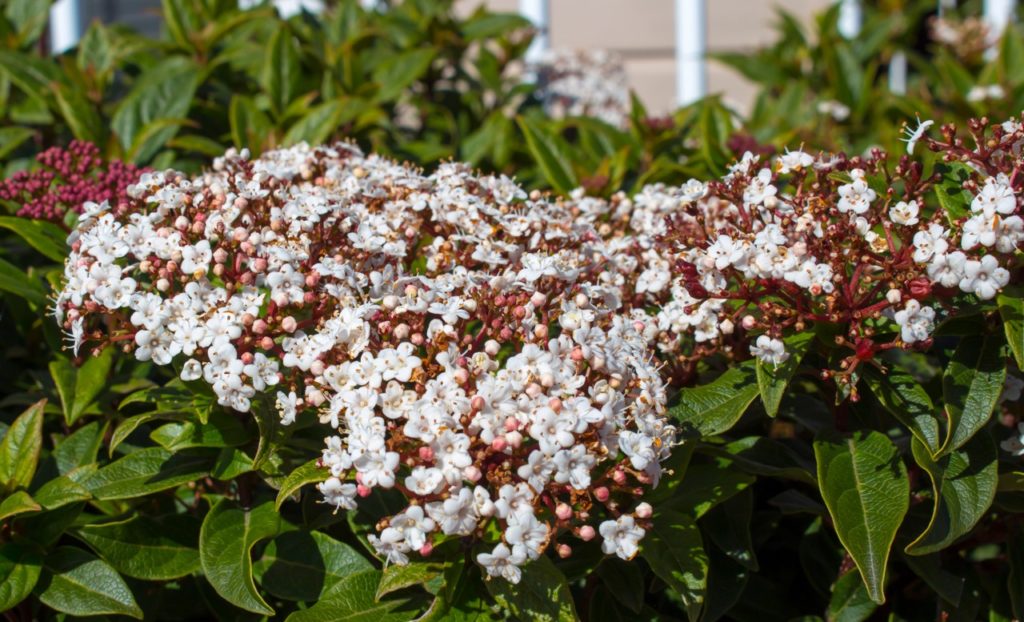
- COMMON NAME(S): laurustinus ‘Israel’
- HARDINESS RATING: H4
- FLOWERS: pink and white
- SUNLIGHT: full shade / full sun / part shade
While ‘Israel’ displays glossy dark green foliage in winter, the flowers are the real crowd-pleaser.
Red flower buds not only form in autumn, but they also open in the same season, with the blooms on show all winter long that continue deep into spring.
As a result, you can enjoy dense spherical clusters of small, snowy white flowers for over 6 months of the year.
Climbing up to 3m in height and spread, this is a big, evergreen shrub that would be great for hedging.
5) V. lucidum
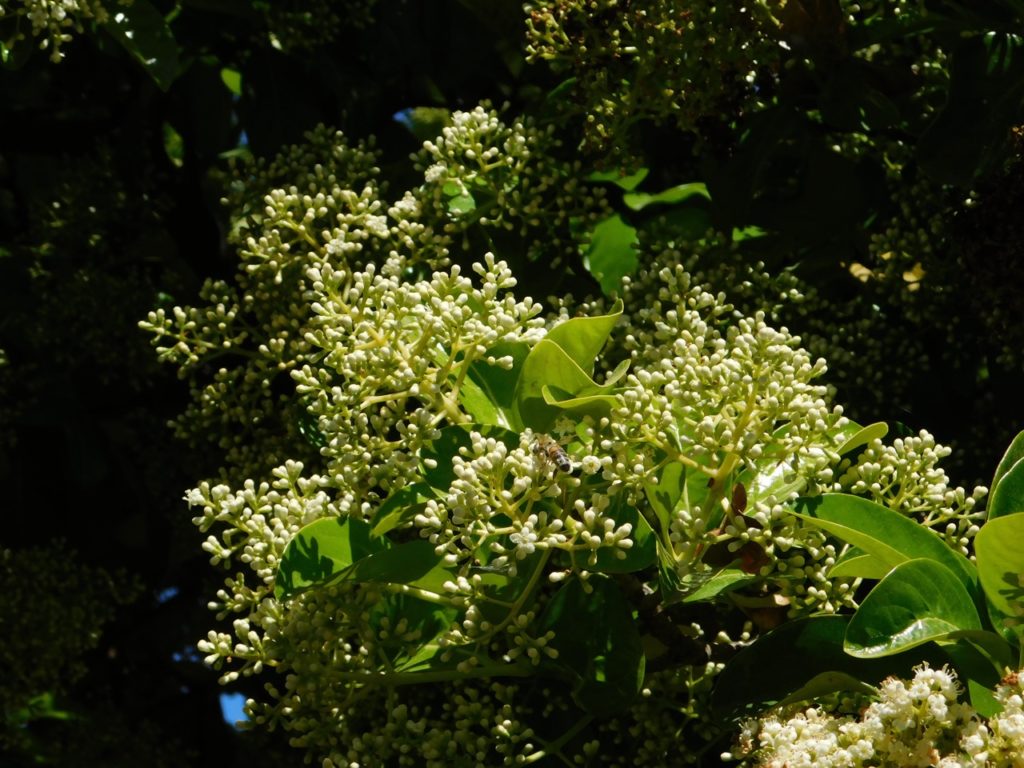
- COMMON NAME(S): laurustinus ‘lucidum’
- HARDINESS RATING: H4
- FLOWERS: cream and white
- FRUIT: blue and black
- FRUITING SEASON(S): autumn / winter
- SUNLIGHT: full shade / full sun / part shade
The largest of our winter-flowering selections, ‘Lucidum’ can reach a good 4m tall and wide.
It has oblong leaves of a dark, smoky green shade and the winter buds give way to small white flowers which last well into spring.
These flowers are borne in flat, lacecap flowerheads which are quite large, at 8-10cm across.
Formed in autumn, the deep blue berries provide further winter colour.
6) V. × bodnantense
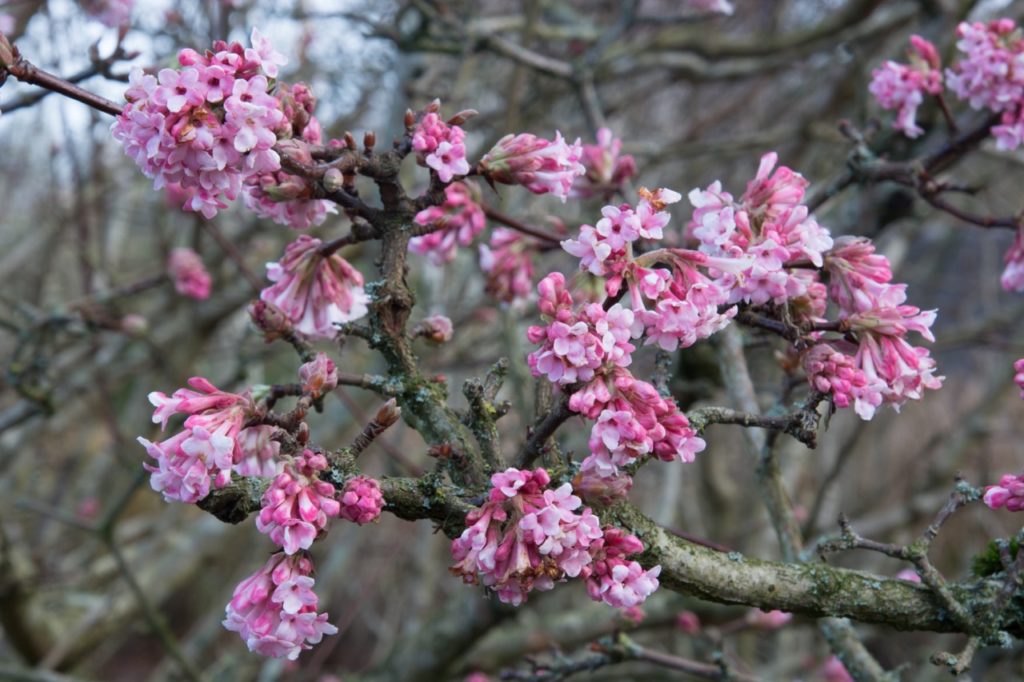
- COMMON NAME(S): bodnant viburnum
- HARDINESS RATING: H6
- FLOWERS: pink and white
- SUNLIGHT: full sun / part shade
One of the original winter-flowering varieties, Viburnum × bodnantense is a stunning large shrub that can reach over 3m high.
As its deciduous branches become bare in autumn, it starts forming buds that open to reveal small flowers in clusters.
Their colour varies from pink-flushed white to candy pink, but they all have the same sweet fragrance.
The flowers last long and keep coming through winter and into spring and can sometimes last up to half the year.
7) V. × bodnantense ‘Charles Lamont’
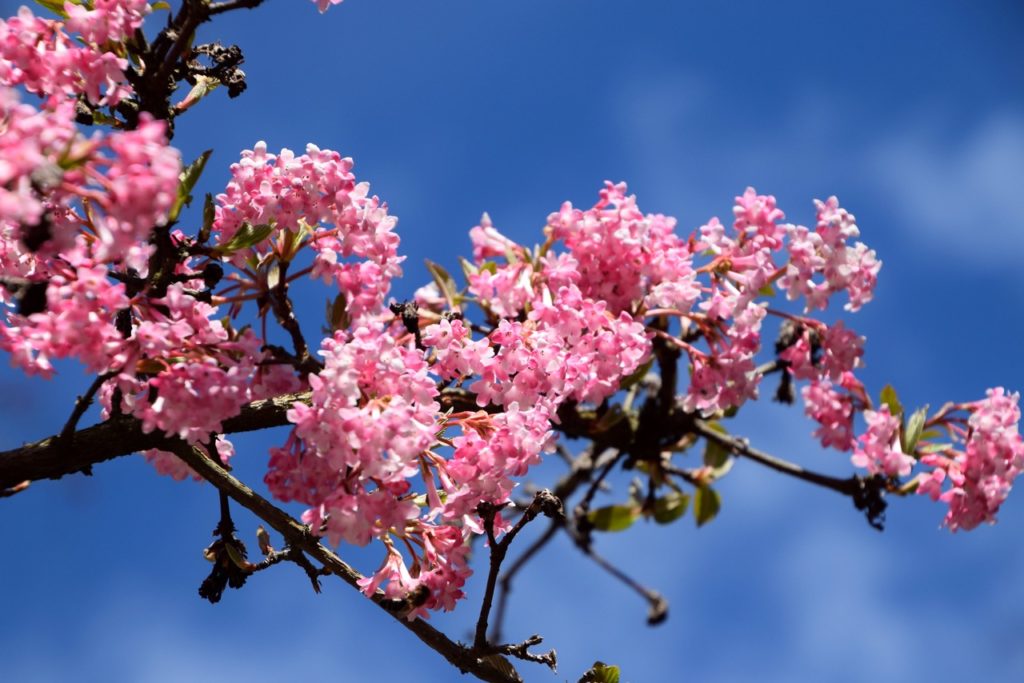
- COMMON NAME(S): laurustinus ‘Charles Lamont’
- HARDINESS RATING: H6
- FLOWERS: pink
- SUNLIGHT: full sun / part shade
‘Charles Lamont’ also boasts a fantastic blooming season and it is floriferous as well.
In autumn, it sets pinky-red buds which open before winter even arrives into small flowers with a sweet fragrance, covering the denuded tree in clusters of soft pink blooms.
These blooms span over winter and well into spring, providing colour for over six months.
It is about 2m high with a somewhat narrower profile.
This cultivar has received the RHS Award of Garden Merit.
8) V. × bodnantense ‘Deben’
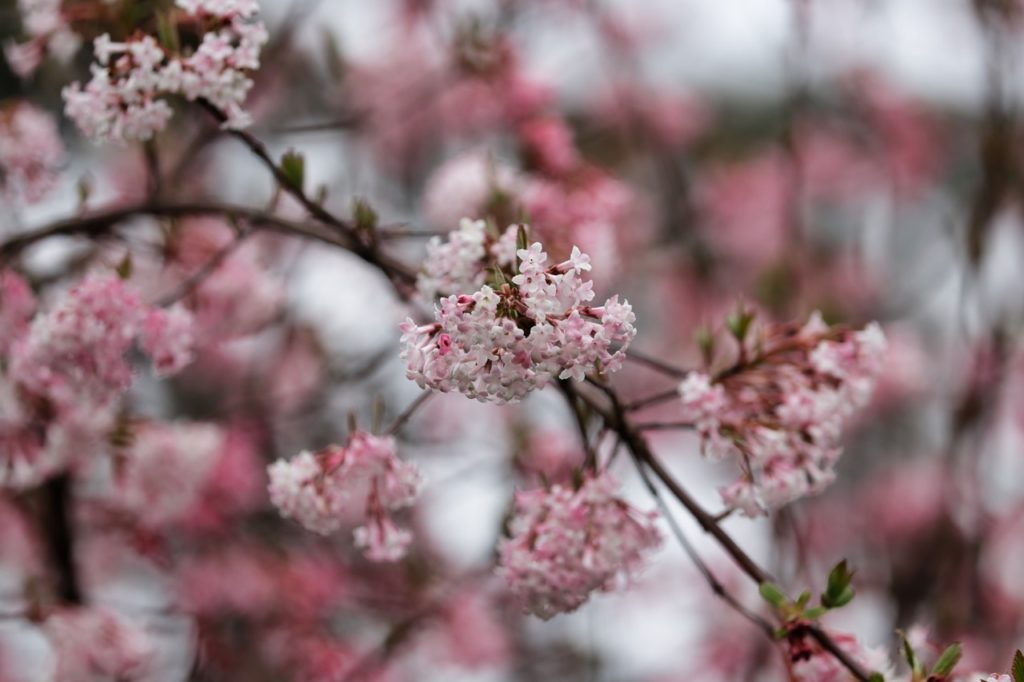
- COMMON NAME(S): arrowwood ‘deben’
- HARDINESS RATING: H6
- FLOWERS: white
- SUNLIGHT: full shade / full sun / part shade
‘Deben’ is another viburnum that can flower for over half of the year with its blooms lasting all throughout the winter.
This cultivar starts forming buds of a baby pink hue in autumn that open to reveal pink-flushed flowers that fade to white.
They release a sweet fragrance and last into spring.
‘Deben’ reaches about 2m in height with a spread of around 1m and has received the RHS Award of Garden Merit.
9) V. farreri
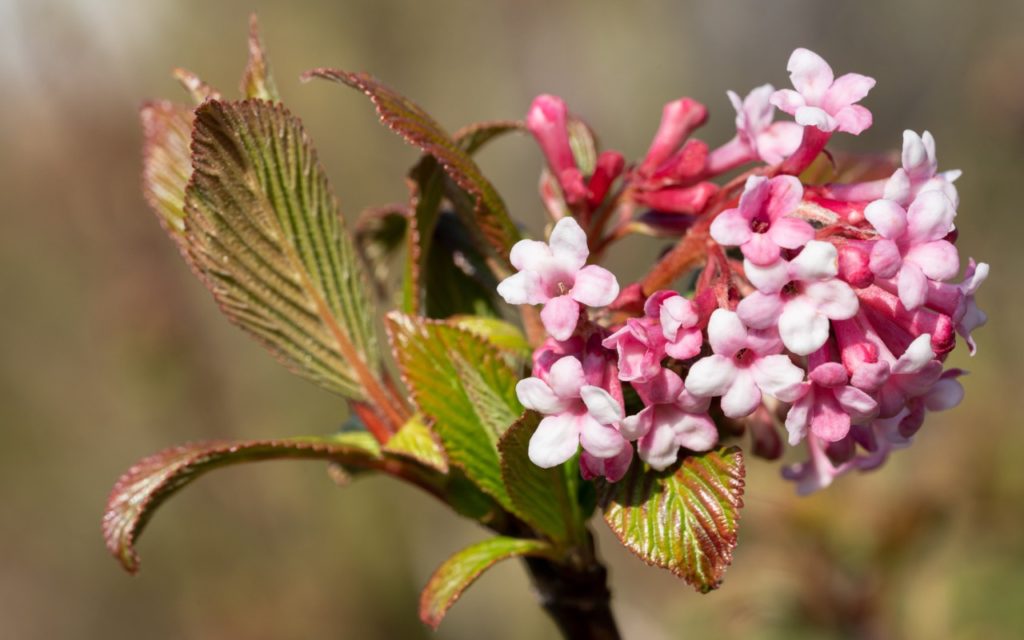
- COMMON NAME(S): farrer viburnum
- HARDINESS RATING: H6
- FLOWERS: white
- FRUIT: red
- FRUITING SEASON(S): winter
- SUNLIGHT: full shade / full sun / part shade
Viburnum farreri doubles the winter joy, with rich clusters of white flowers and bright red berries both on display throughout the season.
“Viburnum farreri is a great choice for winter interest and is a real treat from autumn right through to the festive period,” says Horticultural Consultant Colin Skelly.
“First autumn colour, berries and then flowers, then handing the baton on to the early spring flowering bulbs and shrubs.”
The buds set in autumn, whilst the fragrant flowers open in the same season and continue through winter into spring.
It rises to about 2m tall and has leaves that display conspicuous veining.
This is another variety that has been awarded the RHS Award of Garden Merit.
10) V. farreri ‘Album’
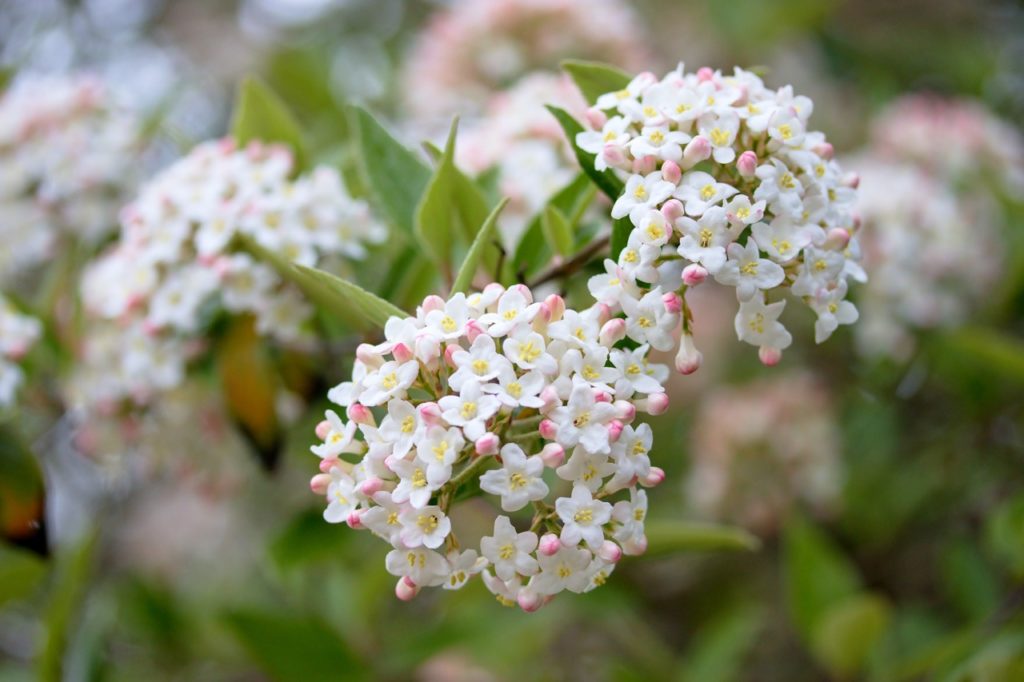
- COMMON NAME(S): farrer viburnum ‘candidissimum’
- HARDINESS RATING: H6
- FLOWERS: white
- SUNLIGHT: full sun / part shade
If you’d like to see flowers whiter than the snow that decorate bare branches, this is the cultivar for you.
It is of an upright habit and reaches a good 3m in height.
Like the above, this cultivar also has prominent veining on its leaves.
The little clusters of flowers have a shorter blooming season than the species, with buds forming in autumn and flowers fading at the end of winter, but they are pure white and wonderfully fragrant.
11) V. farreri ‘December Dwarf’
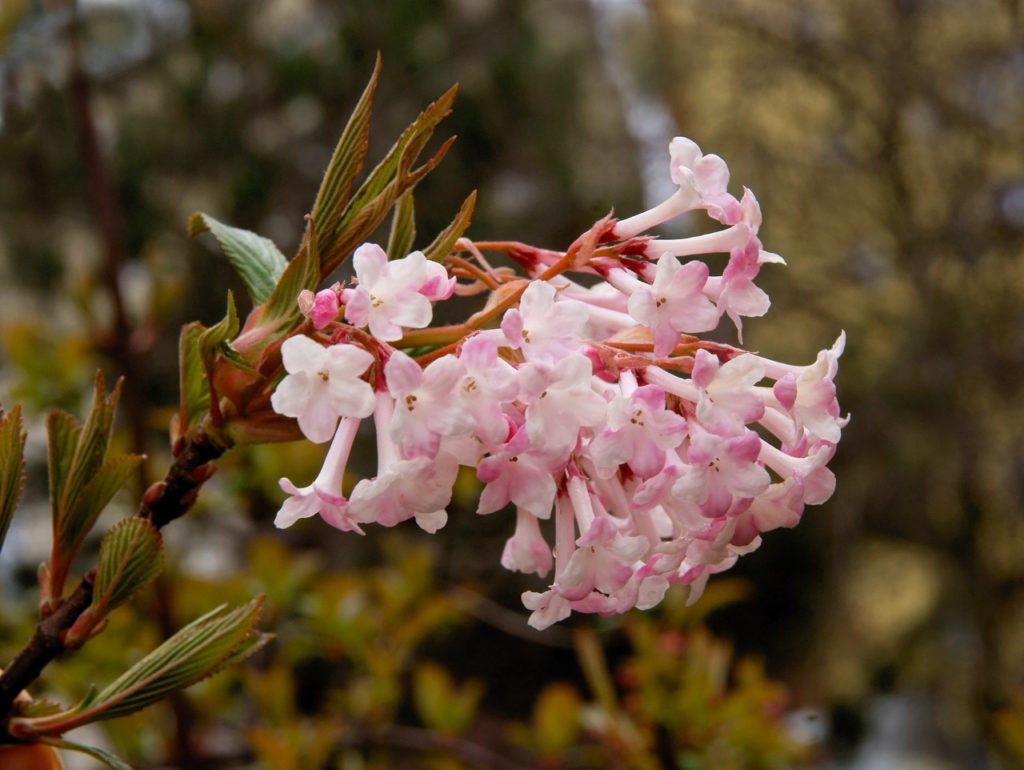
- COMMON NAME(S): farrer viburnum ‘December dwarf’
- HARDINESS RATING: H7
- FLOWERS: pink
- SUNLIGHT: full sun / part shade
Growing to only about 1m high and wide, ‘December Dwarf’ is the most aptly named entry on our list.
This tidy deciduous shrub’s deeply-veined leaves display rust and russet autumn colours before its buds and flowers are seen.
Clusters of flowers appear on the dwarf’s bare stems in December, as its name suggests, and they last well into spring.
They are a soothing pastel pink and are wonderfully fragrant.
12) V. carlesii ‘Aurora’
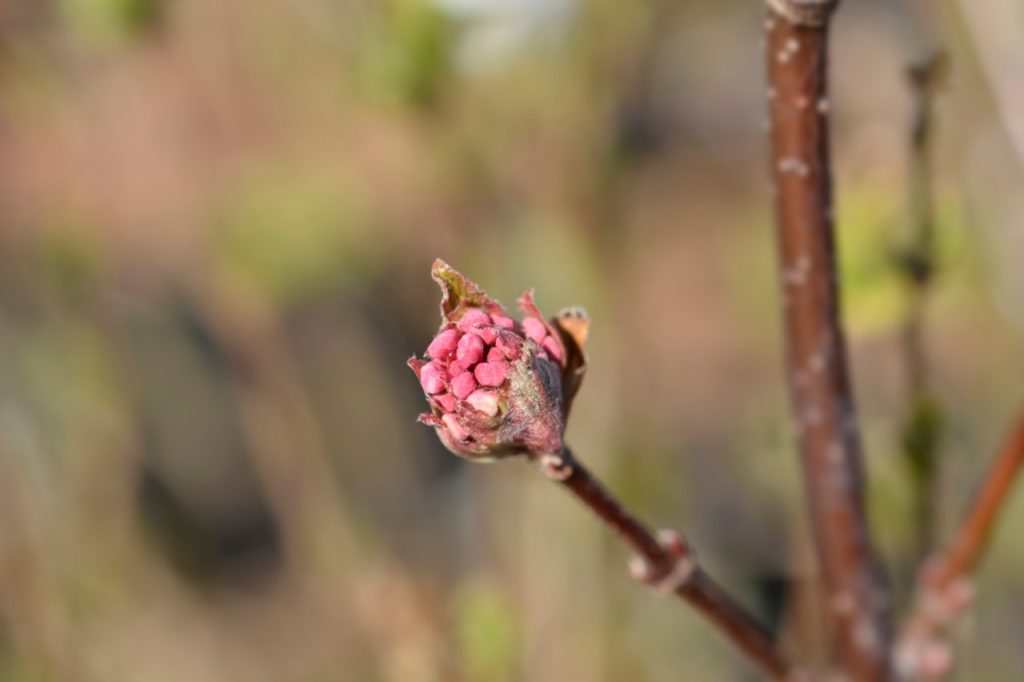
- COMMON NAME(S): arrowwood ‘aurora’
- HARDINESS RATING: H6
- FLOWERS: pink and red
- FRUIT: black and red
- FRUIT SEASON(S): autumn
- SUNLIGHT: full shade / full sun / part shade
Although deciduous Viburnum carlesii shrubs are typically spring-flowering types, ‘Aurora’ reliably sets its buds in winter, with flowers starting to open even before the season bids farewell.
Their buds give way to rounded clusters of pastel pink flowers that are sweetly scented.
In winter, you can also catch bunches of those red and black berries left over from autumn.
Another recipient of the RHS Award of Garden Merit, this delightful shrub is perhaps my favourite on the list.
References
- 1Ornamental Plants. (2021, July). Royal Horticultural Society. Retrieved March 27, 2023, from https://www.rhs.org.uk/plants/pdfs/agm-lists/agm-ornamentals.pdf

